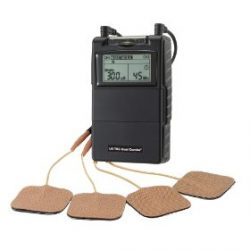Years ago I had a friend that was selling Electrical Muscle Stimulators for your abs or any other muscle group you wanted to use it on.
The way that is worked was that you could put it across your stomach and it would send electric pulses through your muscles and help you lose or get a six pack or make you huge.
The claims were not very well proven then and are still somewhat suspect. I do not think you are going to see a Mr Olympia from electocuting himself but anyway I ran into an FDA question and answer about these Electronic Muscle Stimulators that I wanted to pass on:
Consumer Info – Electrical Muscle Stimulators
Q. Why does FDA regulate electrical muscle stimulators?
A. Electrical muscle stimulators are considered devices under the Federal Food, Drug, and Cosmetic Act. Under this law and the agency’s regulations, the FDA is responsible for regulating the sale of all electrical muscle stimulators in the United States.
Therefore, firms must comply with appropriate FDA premarket regulatory requirements before they can legally sell their stimulators. Most electrical muscle stimulators (EMS devices) that have been reviewed by FDA are intended for use in physical therapy and rehabilitation under the direction of a health care professional.
If a company wants to sell EMS devices directly to consumers, the company needs to show FDA it can be used safely and effectively in that setting.
 Q. These electrical muscle stimulators are advertised not only to tone, firm, and strengthen abdominal muscles, but also to provide loss, girth reduction, and “rock hard” abs. Do they really work?
Q. These electrical muscle stimulators are advertised not only to tone, firm, and strengthen abdominal muscles, but also to provide loss, girth reduction, and “rock hard” abs. Do they really work?
A. While an EMS device may be able to temporarily strengthen, tone or firm a muscle, no EMS devices have been cleared at this time for loss, girth reduction, or for obtaining “rock hard” abs.
Q. Is FDA concerned about the unregulated marketing of these devices?
A. Yes. FDA has received reports of shocks, burns, bruising, skin irritation, and pain associated with the use of some of these devices. There have been a few recent reports of interference with implanted devices such as pacemakers and defibrillators.
Some injuries required hospital treatment. It is very important that these devices be properly designed, manufactured, and labeled with clear and complete instructions for use and that anyone using them follows the instructions carefully. FDA is also concerned because many of these devices have cables and leads.
If those cables and leads do not comply with electrical safety standards, there is the possibility of electrocution by users and other household members. FDA is currently investigating firms that are illegally marketing EMS devices.
Q. What does FDA regulation accomplish?
A. Firms that market EMS devices are required to comply with appropriate FDA premarket regulatory requirements before they may legally sell their devices.
The firm must be able to demonstrate that these devices are as safe and as effective as similar devices that are legally marketed. Devices may only be marketed for uses that are established for the device or for uses that the firm can support with data.
At this time, FDA is not aware of scientific information to support many of the promotional claims being made for numerous devices being widely promoted on television, infomercials, newspapers, and magazines.
Q. Why should I select an electrical muscle stimulator that is legally marketed according to FDA regulations?
A. Electrical Muscle Stimulators that have not met FDA premarket requirements are illegal, and the FDA has not determined whether or not they are properly designed, manufactured, and labeled to provide reasonable assurance that they are safe and effective.
Q. Does that mean that it’s unsafe to use an electrical muscle stimulator that has not met FDA requirements?
A. Using a product that has not met FDA requirements isn’t necessarily unsafe or dangerous. But it could be. FDA has received reports of shocks, burns, bruising, skin irritation, pain, and interference with other critically important medical devices (e.g., pacemakers) associated with the use of unregulated products.
Unregulated devices also may have safety problems associated with cables and leads that can lead to accidental shock and electrocution by users and other household members, including children.
Q. If I use an electrical muscle stimulator that has met FDA regulatory requirements, will it give me the same kind of effect that lots of sit-ups, stomach crunches and other abdominal exercises will?
A. Using these devices alone will not give you “six-pack” abs. Applying electrical current to muscles may cause muscles to contract. Stimulating muscles repeatedly with electricity may eventually result in muscles that are strengthened and toned to some extent but will not, based on currently available data, create a major change in your appearance without the addition of diet and regular exercise.
Q. But hasn’t FDA cleared electrical muscle stimulators to treat medical conditions?
A. Yes. The FDA has cleared many electrical muscle stimulators for prescription use in treating medical conditions. Doctors may use electrical muscle stimulators for patients who require muscle re-education, relaxation of muscle spasms, increased range of motion, prevention of muscle atrophy, and for treating other medical conditions which usually result from a stroke, a serious injury, or major surgery.
Again, the effect of using these devices is primarily to help a patient recover from impaired muscle function due to a medical condition, not to increase muscle size enough to affect appearance.
Q. Are there any OTC EMS devices that have met FDA’s regulatory requirements?
A. Yes. At this time, Slendertone Flex marketed by BMR NeuroTech, Inc., has been cleared by FDA for toning, strengthening and firming abdominal muscles.
What are your experiences with Electrical Muscle Stimulators and have they worked for you at all?




